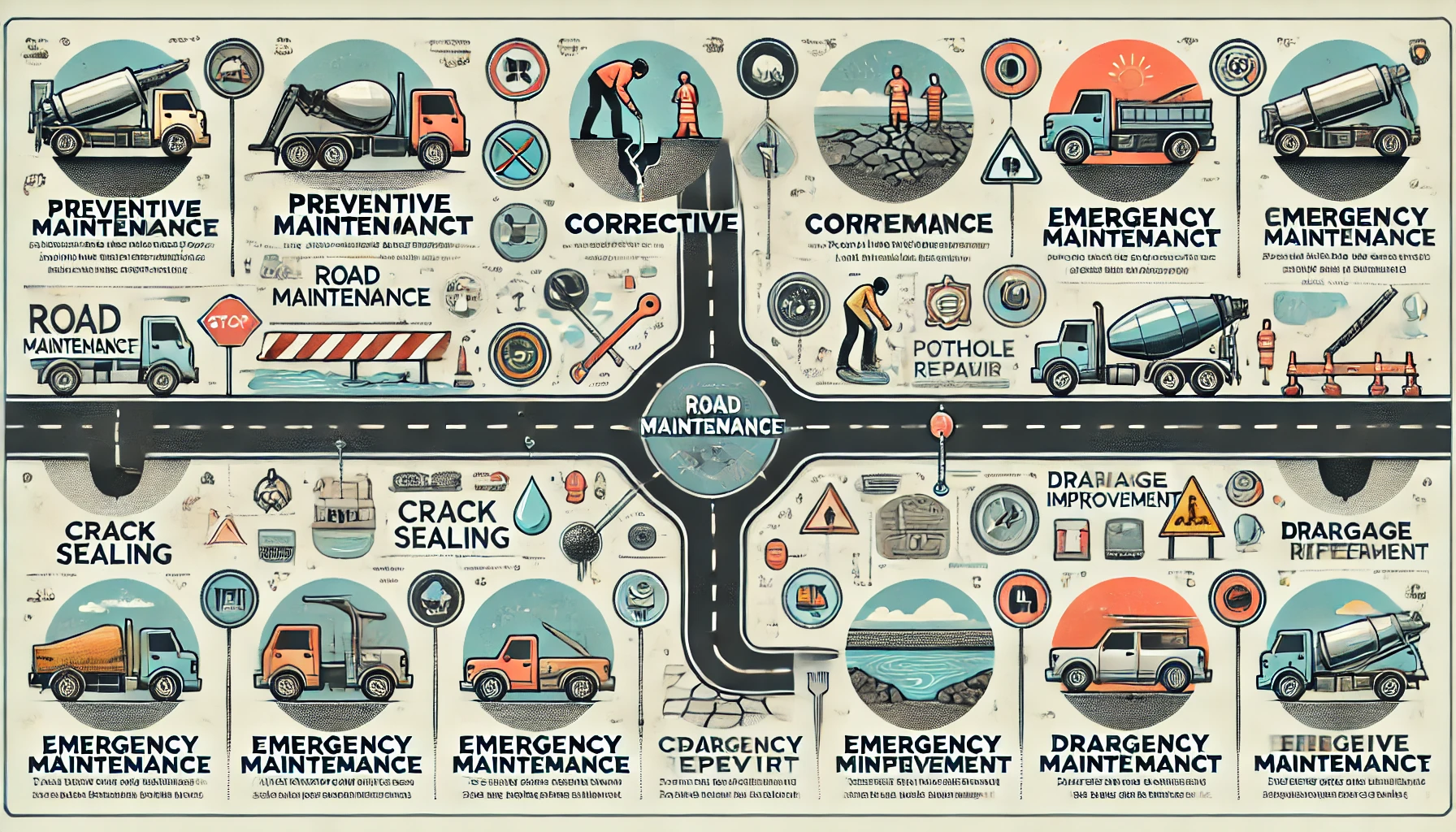Road maintenance is a critical aspect of infrastructure management that ensures the safety and longevity of road networks. Effective road maintenance strategies not only enhance the driving experience but also reduce long-term costs by preventing severe damage. In this article, we will explore various road maintenance techniques and strategy, providing insights and examples to help you understand how these methods work and why they are essential.
Routine Road Maintenance
Routine maintenance involves regular, scheduled activities aimed at keeping the road surface and infrastructure in good condition. These tasks are typically less intensive and are performed frequently to prevent minor issues from becoming major problems.
Surface Cleaning and Debris Removal
One of the simplest yet most effective routine maintenance activities is surface cleaning and debris removal. This involves clearing the road of litter, leaves, and other debris that can cause drainage problems or surface wear.
Pothole Patching
Potholes are a common issue on many roads, especially in areas with heavy traffic or extreme weather conditions. Pothole patching is a routine maintenance task where damaged areas of the road are filled with asphalt or other materials to provide a smooth driving surface.
Crack Sealing
Cracks in the road surface can allow water to penetrate, leading to further deterioration. Crack sealing involves filling these cracks with sealant to prevent water ingress and extend the life of the road.
Preventive Maintenance
Preventive maintenance is performed to avert the onset of significant road damage. These activities are typically more planned and scheduled less frequently than routine maintenance but are essential for prolonging the life of the road.
Seal Coating
Seal coating is the application of a protective layer on the road surface to shield it from the effects of weather, traffic, and UV rays. This technique helps to extend the road’s lifespan and maintain its aesthetic appeal.
Micro-Surfacing
Micro-surfacing involves applying a thin layer of asphalt emulsion mixed with fine aggregate to the road surface. This method is used to correct minor surface irregularities, improve skid resistance, and seal the surface from water infiltration.
Chip Sealing
Chip sealing is a preventive maintenance technique where a layer of liquid asphalt is sprayed on the road surface, followed by the application of small aggregate chips. This creates a textured surface that provides better traction and protects the underlying road structure.
Corrective Maintenance
Corrective maintenance is necessary when the road has suffered damage that affects its functionality and safety. These activities are more intensive and costly but are crucial for restoring the road to a serviceable condition.
Asphalt Overlay
An asphalt overlay involves applying a new layer of asphalt over the existing road surface. This technique is used to correct surface irregularities, improve ride quality, and extend the road’s life. It is often used when the road has extensive surface wear, but the underlying structure is still sound.
Full-Depth Reclamation
Full-depth reclamation (FDR) is a more comprehensive corrective maintenance technique where the existing road surface and base materials are pulverized and mixed with new stabilizing agents to create a new base layer. This method is used for roads with significant structural damage and provides a cost-effective alternative to complete reconstruction.
Patching
Patching is often used for localized areas of severe damage. This involves removing the damaged section of the road and replacing it with new material. Patching can be a temporary or permanent solution, depending on the extent of the damage and the overall condition of the road.
Innovative Road Maintenance Techniques
With advances in technology and materials, new road maintenance techniques are continually being developed. These innovative methods offer improved efficiency, durability, and environmental benefits.
Cold In-Place Recycling
Cold in-place recycling (CIR) is a sustainable road maintenance technique where the existing road materials are reused on-site. The road surface is milled, mixed with new binding agents, and then reapplied, reducing the need for new materials and minimizing environmental impact.
Geosynthetics
Geosynthetics, such as geotextiles and geomembranes, are used in road construction and maintenance to improve stability, drainage, and load distribution. These materials help to prolong the life of the road and reduce maintenance costs.
Self-Healing Asphalt
Self-healing asphalt is an innovative material that can repair its cracks over time. This technology involves incorporating microcapsules filled with rejuvenating agents into the asphalt mix. When cracks form, the capsules break open, releasing the agents and sealing the cracks, thus extending the road’s lifespan.
Conclusion
Understanding the various types of road maintenance techniques and strategies is essential for maintaining a safe and efficient road network. From routine tasks like surface cleaning and pothole patching to more advanced methods like cold in-place recycling and self-healing asphalt, each technique plays a crucial role in preserving the quality and longevity of our roads. By implementing a combination of these strategies, road maintenance professionals can ensure that our roadways remain in excellent condition for years to come.
Maintaining road infrastructure is crucial for ensuring smooth and safe travel. Effective road maintenance strategies include routine tasks such as pothole patching and debris removal, preventive measures like seal coating and micro-surfacing, and corrective actions including asphalt overlay and full-depth reclamation. By utilizing these techniques, municipalities can extend the lifespan of their roadways, reduce repair costs, and enhance overall road safety. Embracing innovative methods such as cold in-place recycling and self-healing asphalt further contributes to sustainable and cost-effective road maintenance. Adequately maintained roads not only improve traffic flow but also positively impact the environment by reducing the need for frequent repairs.
Key Takeaways
- Routine Maintenance: Regular tasks like cleaning and crack sealing.
- Preventive Maintenance: Techniques such as seal coating and chip sealing.
- Corrective Maintenance: More intensive repairs like asphalt overlay and patching.
- Innovative Techniques: New methods like cold in-place recycling and self-healing asphalt.
Understanding and implementing these road maintenance techniques ensures the longevity and safety of our roadways, providing a reliable infrastructure for all users.


